Legend Of Pure Love…
Thursday, May 3rd, 2012
Artistes, Thespians, Corporate Leaders, Administrators and Members of Government vied with each other to reminisce and pay tributes to Sri Sathya Sai Baba on the morning of 1st May at Royal Turf club grounds, Mahalaxmi, Mumbai.Titled "Legend of Pure Love", Mumbai saw an outpouring of Love among the men and women who packed every inch of available space of the extensive lawns of the Royal Turf club grounds on the blessed evening.
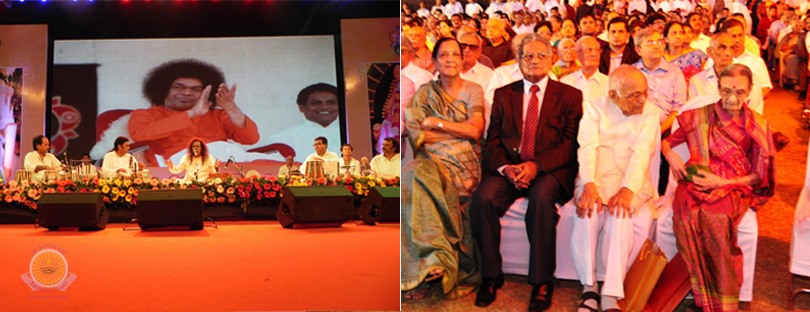
Pandit Shivkumar Sharma set the trend with his faultless rendering. He was followed by Smt. Devaki Pandit, Sri Geet Sagar, Sri Udit Narayan, and Smt. Anuradha Paudwal. There was also a group of students from Sri Sathya Sai Mirpuri College of Music,Prasanthi Nilayam who had come for participating in this great function. These students enthralled the audience with music sung with great devotion. Sri Hariharan's soul stirring performance was the climax of the great evening. Mangala Arathi and singing of National Anthem marked the end. It was almost midnight when the curtains were drawn.
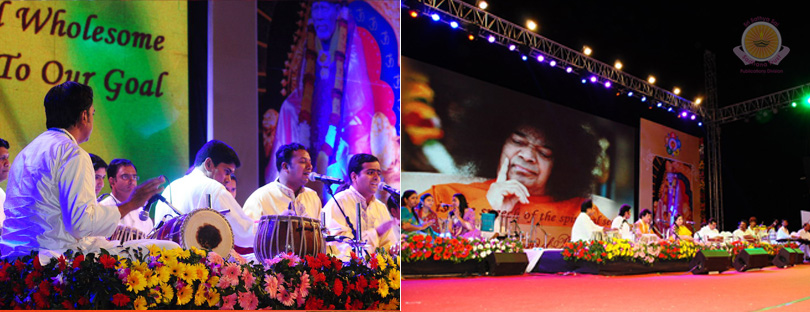
Among the large distinguished gathering were also present Sri K V Kamath, Chairman, Infosys and former Chairman, ICICI Bank Ltd.,Sri Rana Kapoor, Chairman, Yes bank Ltd., Sri Aditya Puri, CEO, HDFC Bank Ltd., Sri Vivek Jain of Western India Royal Turf Club,Sri Venugopal Dhoot, Chairman, Videocon Group of Companies, Smt.Indu Sahani, Sheriff of Mumbai, Smt. Shaina N C, Fashion Designer , Sri Gopinath Munde, BJP Leader, Smt.Jaywantibahen Mehta, Former MP, Sri Mohit Shah, Chief Justice, Mumbai High Court, Smt Geeta Reddy, Minister AP Government.
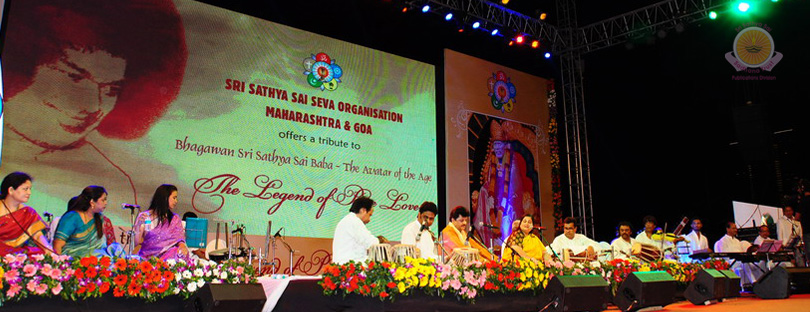
There was a large presence of the representatives from Print and Electronic Media with Live Webcast on Indiatimes, Sanskar, Television Channels in India and 90 other countries.
It may be recalled that Chennai witnessed a similar congregation of artistes who paid a musical tribute to Baba titled"Sangeetha Deeparadhana" on the 17th of March.Dana Gillespie,the famous Blues Singer has already performed in several European locations this past year.Mumbai has enlarged on that tradition setting the stage now for a global phenomenon of such tributes to this true Legend of Pure Love.
sourced:
The Assurance
Thursday, May 3rd, 2012
The Assurance: Faith is being sure of what we hope for and certain of what we do not see, trusting in one's Inner Self and the Word of God. But how many of us have this unflinching faith, that, in trying circumstances we do not fumble and perish? When a devotee takes that one step, surrendering and following Him diligently, He may take him to the nadir testing his mettle, but not before taking those extra steps to bail him out of trouble. Narrating a beautiful story from the banks of Holy Ganges, Prof. Kasturi writes: So, have faith in the Assurance of the Lord; when He says, "why fear, I am here…extracted from December 1962 issue of Sanathana Sarathi.
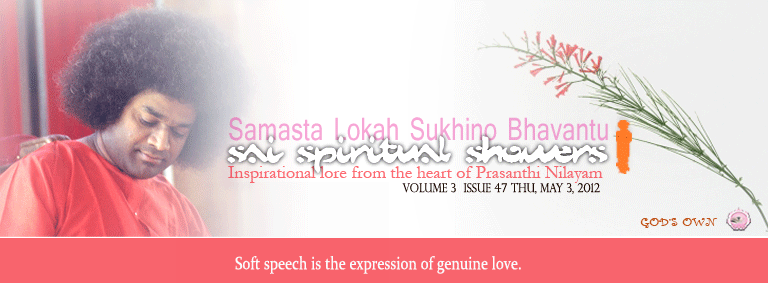 | |
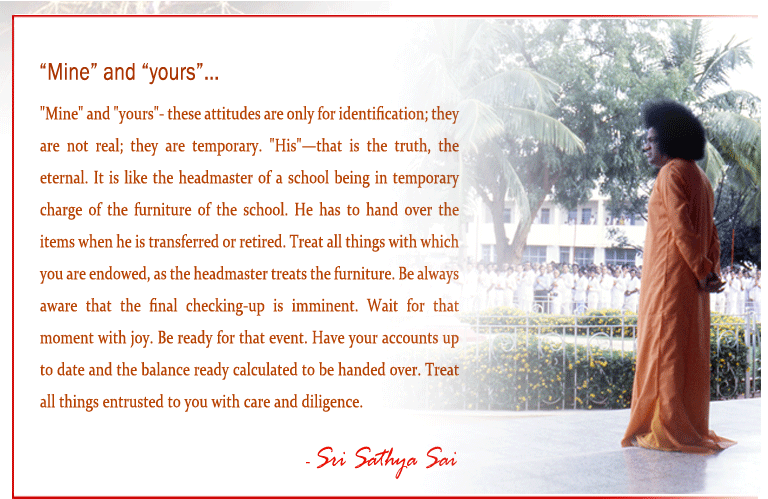 | |
| |
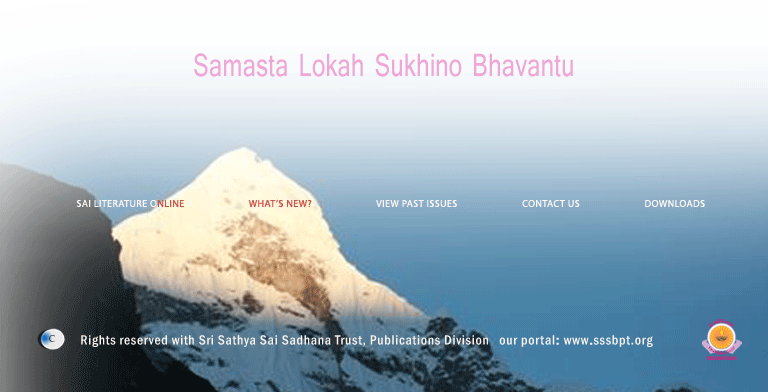 |
sourced:
MAKING THE TRANSITION FROM THE ERA WITH FORM
TO THE ERA WITHOUT THE FORM
TO THE ERA WITHOUT THE FORM
Prof. G. Venkataraman
Commemorating one year of Bhagawan leaving His mortal coil, Prasanthi Nilayam witnessed a three-day ceremony of prayer and divine remembrance entitled 'Sri Sathya Sai Aradhana Mahotsavam" which began on April 23. As part of this function, on all these three days was also held a colloquium "Experiencing the Divine – The Form to the Formless". Prof. G. Venkataraman delivered the Valedictory Address of this colloquium on the evening of April 25, 2012. Produced below is the transcript of this talk.
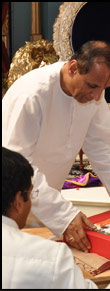 | 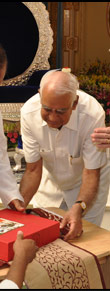 | 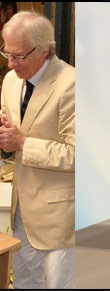 | 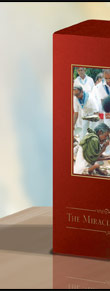 |  |  | 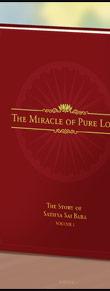 |  |
| The book, 'The Miracle of Pure Love' , a moving biography of Bhagawan Baba, authored by Prof. G. Venkataraman, being released by His Excellency E. S. L. Narasimhan, the Governer of Andhra Pradesh (first from left), on the morning of 24 April, 2012 . Also seen is Mr. Gary Belz (first from right), the head of the team that helped in producing the three-volume book. | |||||||
Most Beloved Bhagavan, as always, I would like to begin by offering my humble, reverential and most loving pranaams at Your Divine Lotus Feet.
I would also like to express my grateful thanks to the Sri Sathya Sai Central Trust for giving me, the opportunity to speak on this occasion, when we are bringing the curtain down on the first ever SAI ARAADHANA celebrations.
Esteemed elders, dear sisters and brothers, and my dear students: Sai Ram to all of you.
Missing the Beautiful Form
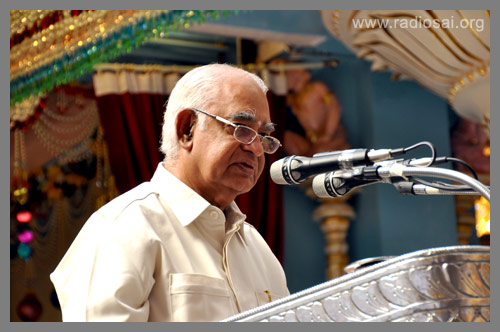 | |
| Prof. G. Venkataraman addressing the gathering in Sai Kulwant Hall, April 25, 2012 |
Time flies quickly, and one year has passed since Swami dissolved into Eternity. Those of us who are deeply attached to the Form – and who is not – continue to feel that something is missing. Inevitably, this brings to my mind a beautiful song that M. S. Subbulakshmi sang in the famous Tamil film Meera. The song begins with the words Engum niraindaiyae, nee indru engu maraindaiyoo? It roughly means: "Oh the One Who is everywhere, where have You disappeared today?"
Today, all of us are asking the same question, even as we cast longing glances in that direction, hoping against hope to suddenly see Swami sitting there as He used to.
Meera posed a question, but got no answer. We, however, have an answer, and that was given to us by Swami Himself a long time ago.
Envisioning Him Inside
In September 1984, Bhagavan gave 34 Divine Discourses on the Bhagavad Gita, in the Bhajan Hall over there, directed specially at students. In one of those talks, Swami said – and this is a paraphrase: "Right now, you are all in this hall. Swami also is here, speaking to you. Later when you go back to your respective places, there would be no Bhajan Hall, and no Swami. All the people you now see around you would also not be there. This absence is purely physical. If, however, you look inside you, you can still see the hall, the audience and Swami; not merely that, you can even hear Swami's words."
The essence of Swami's remark is that the absence we feel is merely at the physical and the material level. If we restrict Swami to merely His Form, then we are bound to feel sad. However, such sadness is our own making, for what right do we have to restrict Him who is transcendental to a mere form?
| |
Dear sisters and brothers, today, as this wonderful Aaraadhana function draws to a close, it is these words of Swami that I just referred to that must form the starting point of our journey forward. In other words, the time has come, not to look for Swami outside but within our hearts, especially because Swami has given us the categorical assurance that if we look for Him there, then we would be able to experience Him far better than we can through our senses.
Carrying Forward the Lord's Legacy
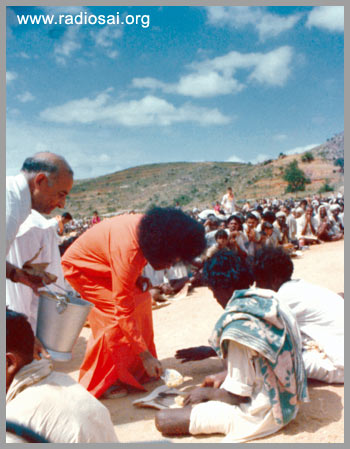 |
Let me move on and introduce now the word legacy, which is often taken to mean something that is handed down from one generation to another. That indeed is usually the case. However, there is also another kind of legacy that is not merely inherited but enduring; legacies left behind by great masters belong to that category.
Those who inherit the legacies of the masters not only cherish what has been handed down to them but also protect, nourish and build upon what has been bequeathed. The immortal legacy that our Beloved Bhagawan has left us is His Love, which was also His life, His Message and His Teaching. And the issue now before us is: "How do we nourish, protect and build upon this legacy?" The rest of my talk would be devoted largely to seeking an answer to this question.
I would like to begin my quest for an answer to the question I just posed, by recalling the observations Swami made at the beginning of His Discourse delivered at the time of the Athi Rudra Maha Yajnam in 2006. Swami said that life is based entirely on Karma or action, and that there is no moment from birth to death when we do not act. We may be fast asleep; yet the heart beats, the lungs breathe, and the blood flows. Swami explained that such involuntary actions also constitute Karma. More important, however, are the actions we consciously engage in and thus also become responsible for. Such actions, Swami emphasised, must always be based on Dharma. And that, said Swami, was the reason why God has blessed us all to be born with the human form.
Animals do not have the capacity for rising to higher levels of consciousness; humans alone have that capability. That is why when animals kill humans, we do not charge them with murder. In the case of humans however, killing a human in civil life is a crime, even in communist countries that are officially atheistic.
Transforming Karma into Dharma
On another occasion, making Seva (service) the theme of His Discourse, Swami said that true Seva can flow only from Prema or Pure Love, and added significantly that Prema without Tyaga or sacrifice is impossible. If now we put these two Discourses together, it becomes evident that just as the Ganga and the Yamuna merge in Prayag and thereafter flow as Akhanda Ganga, Tyaga and Prema must merge and transform mere Karma into Dharma. In short, just as without Gangotri there cannot be any Ganga, so also, without Tyaga, or sacrifice there cannot be any Seva or service.
 |  |  |  |  |  |  |  |
Sai Avatar's Uniqueness - 'Spirituality for All'
All this is nice to talk about but what exactly does it mean in practice, especially as we go forward? That really is the issue facing us, and let me now address it in some measure. I will begin by drawing attention to a fact that is hardly ever appreciated, which, to my knowledge at least is that, Swami is the only Avatar who, in a sense, collectivized spirituality.
I make a particular mention of this because typically, a guru guides each sishya (disciple) individually so that every embodied soul is able to seek a path best suited to it and thereafter struggle to liberate itself. This is not surprising since, at the end of the day, spiritual evolution IS an individual experience. Nevertheless, Swami changed the ball game entirely because this is Kali Yuga. Currently, the population is in billions and not in millions. Besides, the world is heavily interconnected and changes are taking place at an uncomfortably rapid pace. On account of all these factors, the traditional, individual-centric approach would be too slow. Swami therefore made all of us come together, like the members of a huge orchestra, and assumed the role of the conductor. This was His way of mass uplifting, if I may put it that way.
 |  |  |  |  |  |  |  |
Swami did not explain all this to us. He just got us involved doing various things, all of which, however, were part of His Grand Design and Master Plan. Extending the musical analogy, all of us played different instruments and at different times, but guided by one baton. Thus, all of us were a part of His Divine Symphony Orchestra, and this is what I mean by the collectivization of spirituality. What I am trying to say is that from now on, our eyes cannot glance through the score sheets in the front of us or look for guidance from the baton. Instead, each of us must play the music by consulting the score written in our hearts.
The Importance of Gandhiji's Sarvodaya
I am sure I am beginning to lose most of you and so let me, at this point, briefly bring in Gandhiji, in order to make clear what I am driving at. In 1904, while Gandhi was practicing as an attorney in Johannesburg in South Africa, he received from a British friend named Henry Pollack a copy of a book by John Ruskin titled Unto This Last.
Once when Gandhi travelled by train from Johannesburg to Durban, he took this book with him and began reading it. He found the book so profound and compelling that he spent the whole night with it. Four years later, Gandhi wrote a book in Gujarathi paraphrasing Ruskin's ideas and gave it the title 'Sarvodaya'. As Gandhiji himself explained, he arrived at the word Sarvodaya by combining two words namely, sarva meaning all and udaya meaning uplift. Later, the Mahatma described Sarvodaya in his Autobiography as 'Welfare for all'.
 |  |  |  |  |  |  |  |
There is a particular reason why I am referring to all this which is connected with the fact that Gandhi based the Sarvodaya principle on the very first verse of the Isopanishad which runs as follows:
God the Ruler, pervades all there is in this Universe.
Therefore, renounce and dedicate all to Him
And then, enjoy or use the portion that may fall to thy lot.
Never covet anybody's possession.
Therefore, renounce and dedicate all to Him
And then, enjoy or use the portion that may fall to thy lot.
Never covet anybody's possession.
Commenting on this verse, Gandhi says:
 |  |  |  |  |  |  |  |
We have heard Swami tell us the very same thing. Often He would say to us, "Everything already belongs to Me. There is therefore nothing material you can really give Me. But there is one thing you can give Me and that is Prema (Love); that is all I want from you."
Slowly, the different pieces I have been placing before you now begin to connect. The starting point is that Swami wants us to offer Love to Him. How do we do that? Swami says we should do that by seeing Him in all beings. "I am in all," He would often tell us, adding significantly, "Service to man is service to God." If now we link all this to Gandhiji's Sarvodaya, we realise that truly speaking our service must uplift the whole of society. That, may I say, would help us all reconnect to Swami, via the first verse of the Isopanishad. So you see, we really have a reasonably clear roadmap for going forward. There are of course many details to be filled in, some of which I shall seek to, even as I proceed.
I wish to quote the Mahatma just once more, before I go back to where I started from and then wrap everything up. About action, Gandhiji says:
The whole gamut of man's activities today constitutes an indivisible whole. You cannot divide action into water-tight compartments such as social, economic, political and purely religious work. I do not know of any religion apart from human activity.
Deviating from Dharma – the Bane of the Modern Times
If you think about it and link Gandhiji's observation with Swami's remark that all Karma must be based on Dharma, it boils down to one simple rule: "There simply is no single human activity from which Dharma can be excluded, none at all."
There is a specific reason why I am mentioning this. If you look around the world today, thanks to media influence on the one hand and peer pressure on the other, there is an excessive sense of hyper-individualism. Whether we like it or not, the source of all this is the Western world and today, the young as well as the elite, are in a hurry to trash basic values, all in the name of so-called individual freedom. It is sobering in this context to recall what Swami said way back in 1971, at the time of the inauguration of the Anantapur College. Here is a small extract from that Discourse:
India is being forged into a bhogabhoomi – a land of skyscrapers, tinned food, air-conditioning and television. Indians are being shaped into an imitative, insurgent and ill-disciplined mass. They are being transplanted on other soils and encouraged to grow without roots. This is an insult to the past and a sacrilege on the history of Time.
Mind you, this is what Bhagawan said 40 years ago, long before the internet, the smart phone, facebook, twitter and what not.
Dear sisters and brothers, how can Dharma survive if morals are considered optional, when right becomes wrong and wrong becomes right, and truth is defined as being halfway between right and wrong? What chance does Dharma have, when people distance themselves from their Conscience on grounds of being amoral? This is what Pope Benedict famously referred to as the tyranny of relativism.
The English language might provide nice and convenient words that might suit those who are dominated by the mind, but I can assert without the fear of contradiction that in Swami's dictionary there is nothing in between Dharma and adharma. One is either for Dharma or against it; the choice is as clear as that and it is foolish to claim, as many do in the name of globalisation, etc., that values have outlived their utility.
 |  |  |  |  |  |  |  |
On the issue of the relevance of values today, I beg to differ and differ strongly from the prevailing attitude. Swami has repeatedly reminded us that there is Sathya in the air of this land, Dharma in its soil, and Prema in the waters that flow. Why? Because this land has been sanctified for thousands of years by countless, sages, saints and seers. And that, as Swami explained to Hislop, is also the reason why God incarnates here, again and again. By way of adding fine print to the above remark, allow me to recall briefly a conversation I was blessed to have with Swami around 1998, I think.
Dharma Needs to be Highlighted and Propagated
Swami was in Brindavan, and one morning after Darshan was over, Swami went for a short ride and took me along with Him. I was seated in the front while Swami was in the back seat, and after a while, I hesitantly turned back and asked, "Swami, why is there so much adharma (unrighteousness) in the world?" Swami did not answer and I said to myself, 'there goes my question.' A little later Swami asked me: "What is the mood like in Sai Ramesh Hall before Swami comes out for Darshan?"
I replied, "Swami, there is absolute silence and an electrifying atmosphere. More than anything else, there is a joyous air of expectation, with everyone craning his or her neck in the direction of the Mandir to see if Swami is coming."
 |  |  |  |  |  |  |  |
Swami slowly replied, 'Oh I see,' and again lapsed into silence. I was not sure why Swami asked the question; nor was I certain whether the reply I gave was what He expected. After a minute or so, Swami spoke again to ask another question. This time it was: "Suppose a child suddenly cries at that time; what happens?"
I replied: "Swami, everyone turns in the direction from which the sound is coming, to find out who is crying."
Once again Swami gave the cryptic reply, 'Oh I see,' and became silent.
I was lost trying to figure out what was going on when Swami suddenly said, "You see, that exactly is what is happening in the world about Dharma and adharma. There is not as much adharma in the world as you seem to think. What is actually happening is that thanks to the media and people's curiosity, adharma always gets a lot of attention. There are so many people doing good, but who is bothered about that? Dharma is simply ignored by one and all, and there is just no one to speak about it – that really is the problem of today's world, and that is what makes people like you think there is more adharma than Dharma."
I was just blown away by how, step by step, Swami not only answered my question, but also corrected the wrong impression I had.
Dear sisters and brothers, I do not know what you make of that conversation but to me it sent the following message: Dots exist, but unless the dots are connected, there would be no line, and without a line, we cannot make a circle. In other words, while there are millions of good people, but unless they join hands adharma cannot be encircled, contained and checked.
It is my submission that we who have been particularly blessed, have a key as well as a collective role to play in strongly check-mating adharma. Without such affirmative action, true Shanti and Sarvodaya are simply not possible. In my view, if the situation has to improve, then Dharma must roar like a triumphant lion and not snore like a sleeping tiger or mew like a disappointed cat!
Baba Answer to Should India Go Nuclear
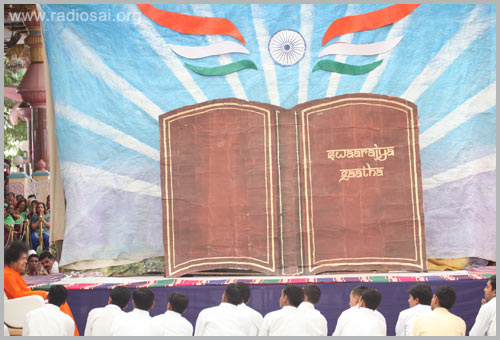 |
It is true Avatars come to arrest the destabilisation of Dharma, but their work has to continue even after they withdraw. Swami hinted at this in a little-known but most significant remark He made way back in 1968. That year, while on a visit to Mumbai – in those days it used to be called Bombay – Swami addressed a group of scholars and intellectuals at the Bharatiya Vidya Bhavan. After He finished Swami was asked many questions and one of them was: "Baba, do you think India should go nuclear?"
At that time, India had not yet gone nuclear and the nuclear issue used to receive much attention in the press and from the intellectuals. Swami's reply was breath-taking and also profound.
Swami said, and here I am giving a paraphrase: "Among the Pandavas, Arjuna was intelligent, valorous and highly skilled in archery. His brother Bhima was mighty, a ferocious warrior and unmatched in use of the club as a weapon. Compared to these two, the eldest among the Pandavas, namely Dharmaputra, was physically somewhat smaller in stature and not so proficient in the martial arts. Yet, Arjuna and Bhima, always bowed to Yudhishtra. Why? Because Yudhishtra was the very embodiment of Dharma. That is the kind of respect Dharma always commands. In the comity of nations, America is like Arjuna while Russia is like Bhima. India should be like Dharmaputra and give a lead to all countries. India should acquire a high and exalted moral stature, by steadfast adherence to Dharma. If India does that, the countries of the world would bow to India, even if it does not have nuclear weapons. In fact, moral leadership is India's destiny."
Marching on with the Torch of Love
Dear sisters and brothers, time and again Swami has declared that India is the engine that has to pull the train made up of all the other countries. If India is the engine, then Dharma is the fuel for this engine and, if I may say so, all of us must, in various ways, individually and collectively and especially via the various institutions of the Sai Organisation we might be connected with, serve as the carriers of the fuel. In that sense, while one curtain comes down, another goes up signalling a new scene that would see all of us marching towards our tryst with the Destiny that Swami has specially carved out for us!
 |  |  |  |  |  |  |  |
The task ahead is not easy. But let us not also forget that the huge chariot of Lord Jagannath in Puri – or juggernaut as the Brits refer to it - can and does move, when pulled by devotees! Inspired by that example and thanking our Dear Lord Sai for this great blessing, let us pick up the torch of Prema (Love) and march forward crying loudly: JAI SAI RAM! Thank you.
sourced:
























No hay comentarios :
Publicar un comentario